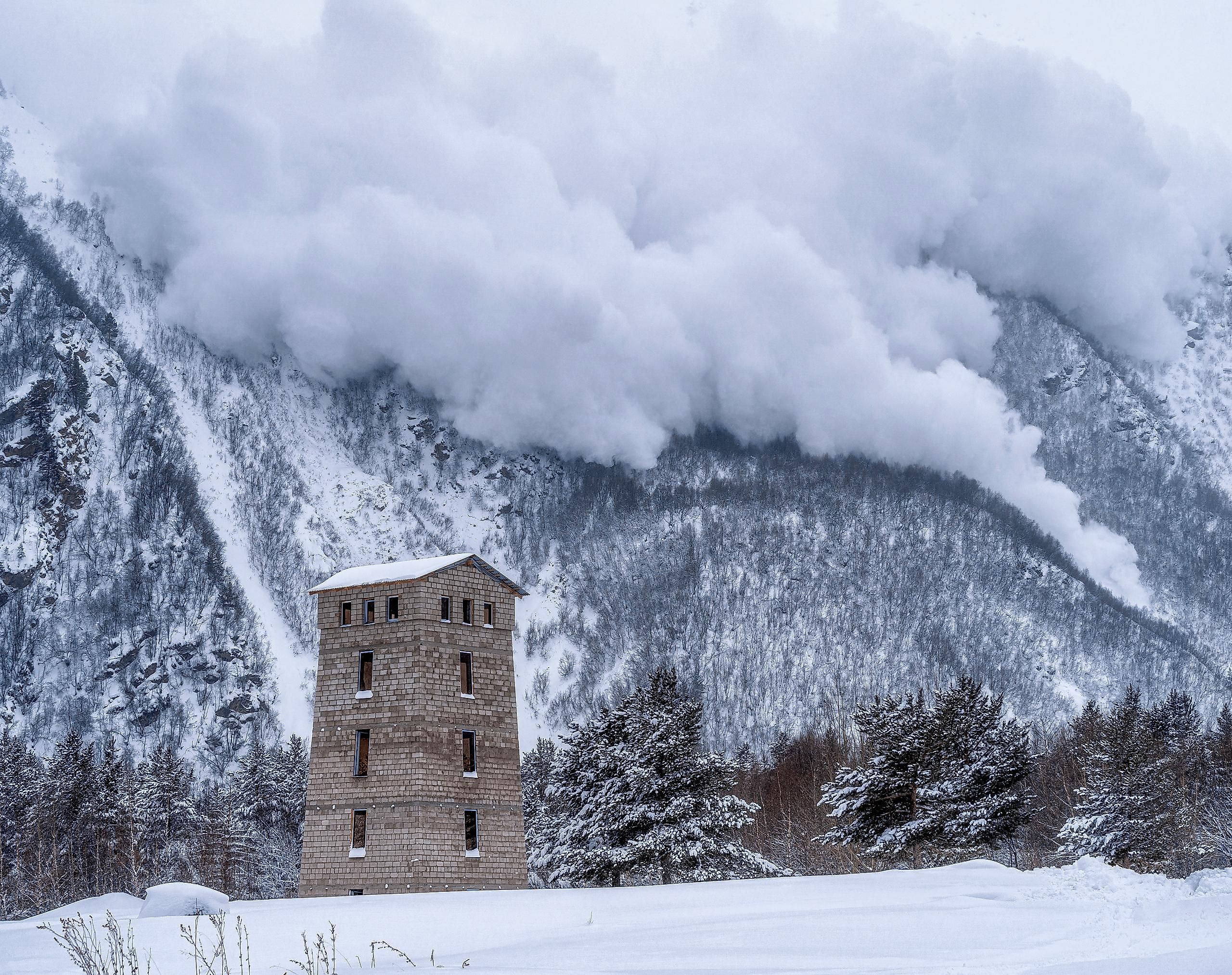
Landslides And Avalanches
Landslides and Avalanches are the most destructive geological disasters that lead to the loss of thousands of precious lives and cause severe economic damages. Both natural and artificial factors are responsible for these disasters. However, in recent times, various anthropogenic human activities supported by global warming and climate change have increased the frequency of such natural disasters. It is estimated that between 1998 and 2017, more than 4.8 million people worldwide have been affected by landslides, which has also led to over 18,000 deaths. Similarly, avalanches are considered the most severe natural hazard to lives and property in mountainous areas. A report in 2001 recorded that globally an average of 150 people were killed by avalanches every year.
Landslides
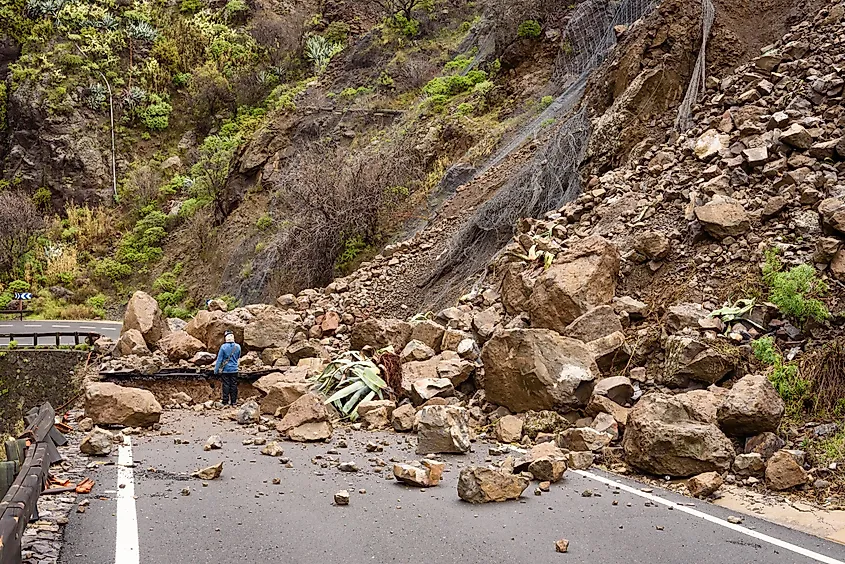
Also called landslips, Landslide is a form of mass wasting which involves a rapid downslope movement of rocks, soil, or debris under the force of gravity. Landslides occur in various environments that have either steep or gentle slope gradients, starting from mountain ranges and coastal cliffs to even underwater regions. Although landslides can be caused by a variety of natural and artificial factors, the principal driving force for landslides to occur is the gravitational force. A landslide mainly occurs when the gravitational pull becomes much greater than the friction of the rocky material on the slope and the internal strength of the rocky material. Sometimes excessive water adds significant weight to the rocky material on the slope, triggering landslides. This explains why landslides are common during the wet season and after heavy storms.
Types Of Landslides
Landslides have been categorized into the following types as per the latest classification by Hungr, Leroueil, and Picarelli.
Earthflow Landslides
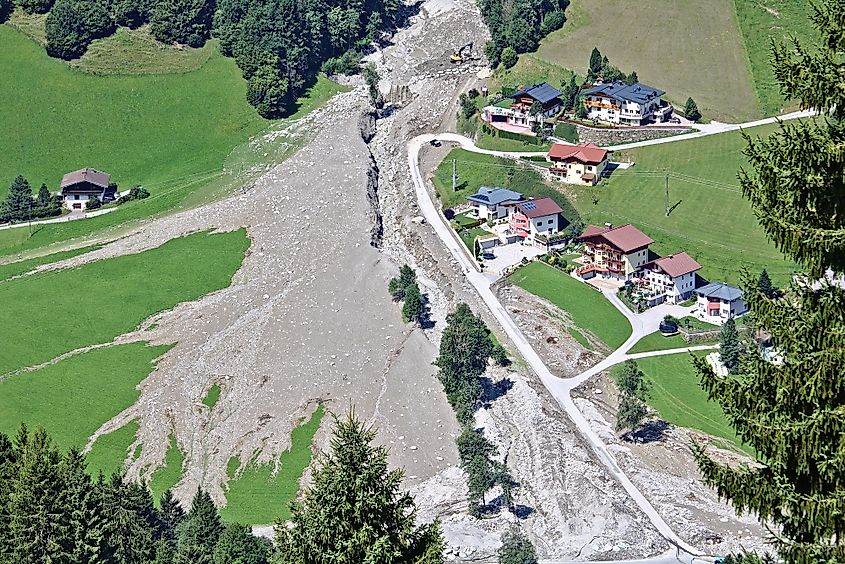
An earthflow landslide refers to the downward movement of fine-grained materials saturated with water under gravitational force. Clays, fine-grained pyroclastic material, silt, and fine sand are some materials highly susceptible to earth flows. The amount of water content dictates the velocity of the earthflow, with high water content leading to a much higher velocity. Therefore, this type of landslide is common in areas of high precipitation.
Debris Flow
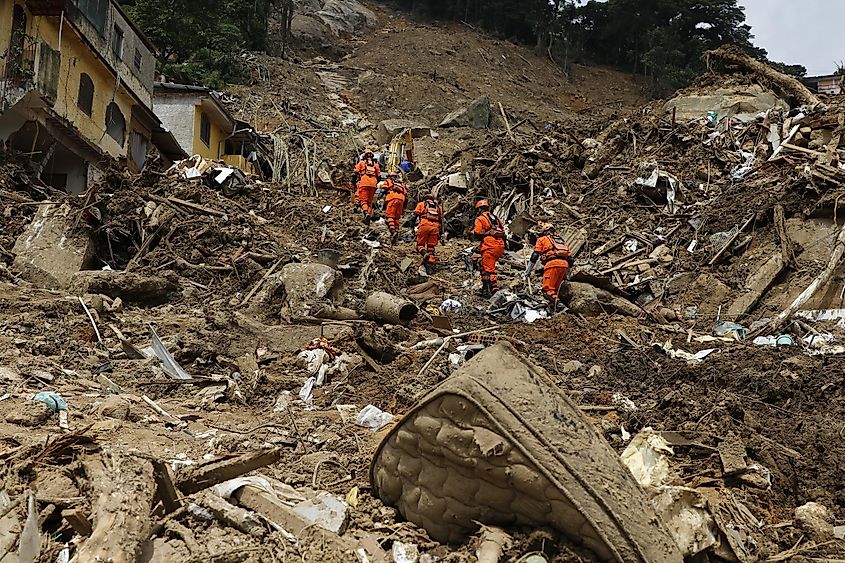
Usually occurring in steep gullies, debris flows have more coarse material compared to mudflows. Heavy rainfall or snowmelt, glacial outburst floods, dam breaking, and intense earthquakes can trigger debris flows, which pose significant hazards in steep mountainous areas. Debris flows are known to damage houses, cars, and bridges, as well as cause floods by blocking the drainage systems.
Rock Avalanche
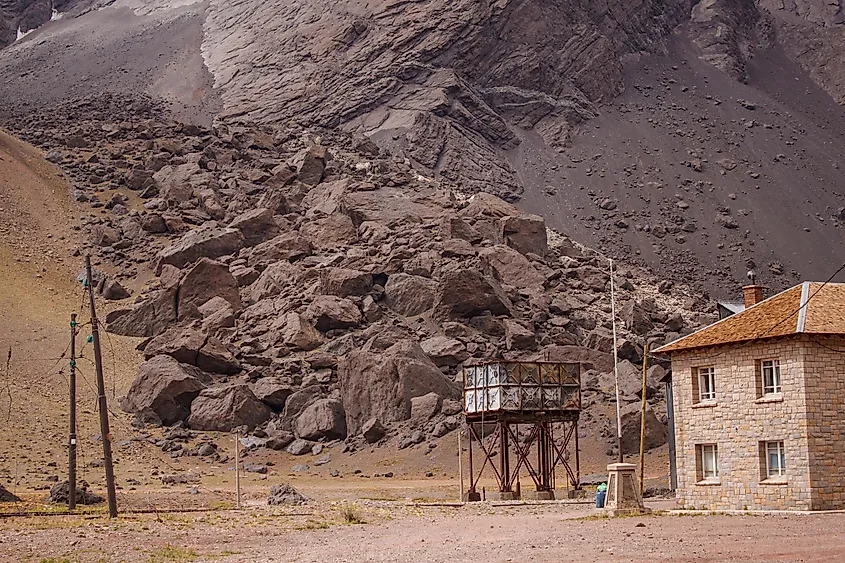
Often called a sturzstrom, a rock avalanche is a massive landslide containing rock and soil, which flows for a tremendous horizontal distance compared to its original vertical drop. The mobility of the flow of a sturzstrom increases with an increase in its volume. Like other landslide types, sturzstroms are triggered by volcanic activities, earthquakes, and heavy rains. Besides Planet Earth, sturzstroms have also been observed on Moon, Venus, Callisto, Mars, lo, Iapetus, and Phobos.
Debris Slide
Debris slide refers to the chaotic flow of rocky material mixed with water or ice. The saturation of thickly vegetated slopes usually triggers this type of movement, and the steeper the gradient, the higher the flow speed. This type of landslide leaves a V-shaped formation and begins with the detachment of chunks of rock on the higher slopes, which break apart while sliding downwards.
Shallow And Deep-Seated Landslides
Shallow landslides occur in areas where the slopes have highly permeable soils on top of low permeable soils. The water trapped by the soft permeable soil generates high hydrostatic pressures. In due course, as the topsoil becomes saturated with water, it becomes heavier, unstable, and slides down the slopes.
In contrast, in deep-seated landslides, the sliding surface is placed below the highest rooting depth of trees. This type of landslide develops along a line of weaknesses such as faults and bedding planes and involves weathered rock, deep regolith, and large slope failures. The steep areas at the toe, and concave scarps at the top, help in the easy identification of the deep-seated landslides.
Causes Of Landslides
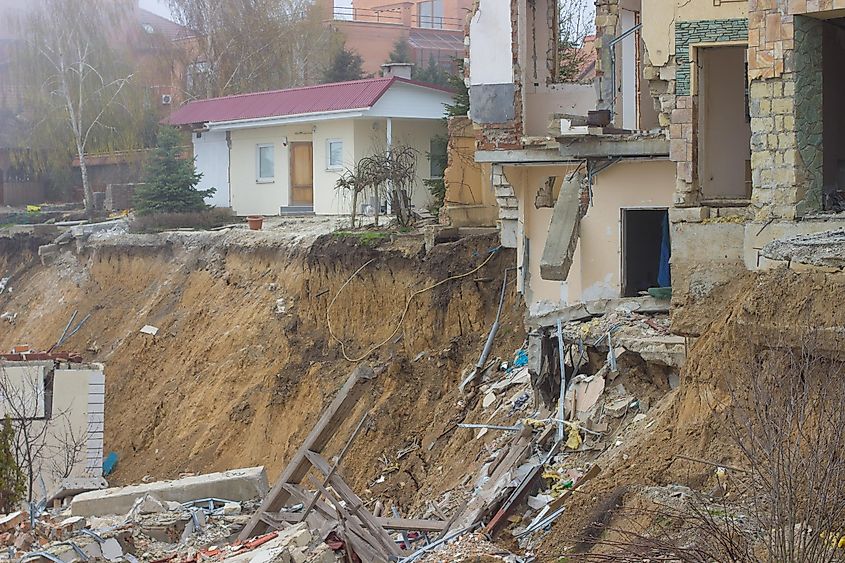
Both natural and man-made activities cause landslides. Some natural causes of landslides include volcanic eruptions, ground shaking by earthquakes, physical and chemical weathering of rocks, increased hydrostatic pressure in the cracks and fissures, absence of vertical vegetative structures, and erosion of a slope top by rivers. Human activities like deforestation, removal of deep-rooted vegetation in shallow soils, forestry activities like logging, vibrations from machinery and traffic, land degradation, blasting, and mining operations cause landslides.
Avalanche
Avalanche refers to the rapid movement of a massive mass of snow down a hill or mountain slope. The term “avalanche” has been derived from the old French term “avaler,” which means “descend” or “go down.” An avalanche can be triggered spontaneously by several factors, such as snowpack weakening, increased precipitation, earthquakes, and human and animal activities. Large avalanches comprising flowing snow and air can capture and move trees, ice, and rocks.
Types Of Avalanches
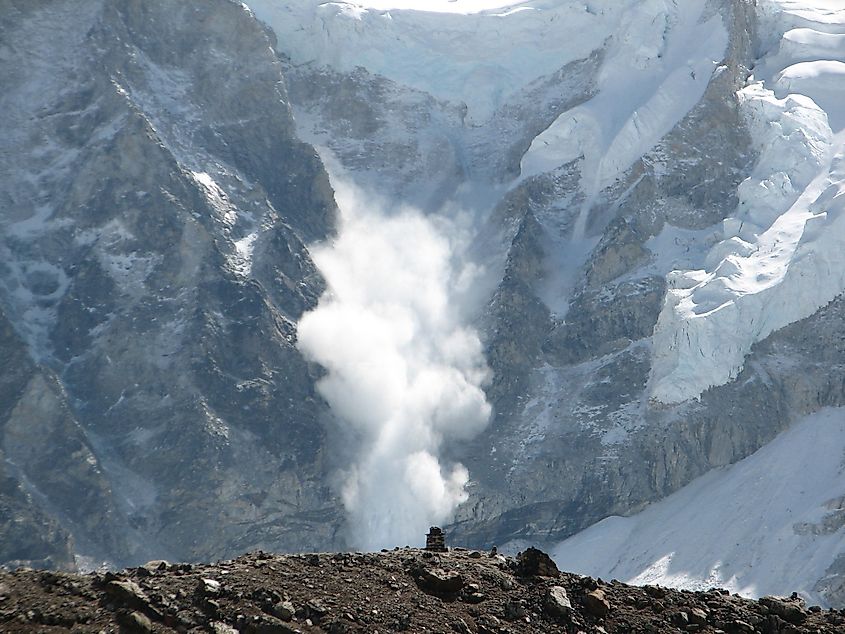
There are two significant forms of avalanches: slab avalanches and loose snow avalanches. A slab avalanche is the most dangerous avalanche type and accounts for over 90% of all avalanche-related fatalities. A slab avalanche involves the rapid movement of a slab (or block) of snow due to the collapse of an underneath weak snow layer. In contrast to slab avalanches, loose snow avalanches are composed of looser snow. It is to be noted that as avalanches accelerate rapidly down the slope, they tend to increase both in mass and volume.
Moreover, during this fast movement of the avalanche, some snow might mix with air creating a powder snow avalanche. This type of avalanche can flow along flat valley bottoms for long distances, carrying masses of about 10,000,000 tonnes and having speeds of more than 190 mph. In addition to the above-mentioned two types of avalanches, there are also other types of avalanches, including wet snow avalanches and ice avalanches.
Causes Of Avalanches
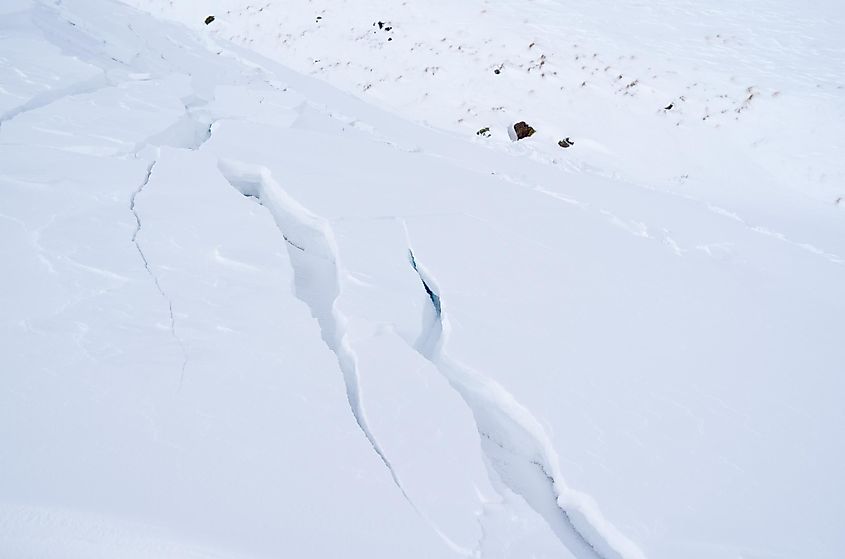
The major factors responsible for avalanches' occurrence include the terrain's slope, the snowpack's characteristics, and the trigger. While moving down a slope, an avalanche follows a specific pathway that depends on the degree of steepness of the slope and the volume of snow or ice that flows down. Several studies have reported that the beginning of an avalanche occurs on a 30 to 40-degree slope, whereas the track of the avalanche takes place on a 20 to 30-degree slope. The avalanche finally stops at the Runout Zone, which is usually the place where the slope has a steepness of lower than 20 degrees.
It is to be noted that under the influence of varying meteorological conditions like wind, temperature, and humidity, the snow accumulated on the surface forms different layers known as snowpack. The varied weather conditions lead to changes in the surface and subsurface layers of the snowpack. An unstable snowpack is created when a slab of cohesive snow sits atop a weak layer. In such cases, only a small additional weight on the upper solid layer can lead to the collapse of the lower layer leading to an avalanche.
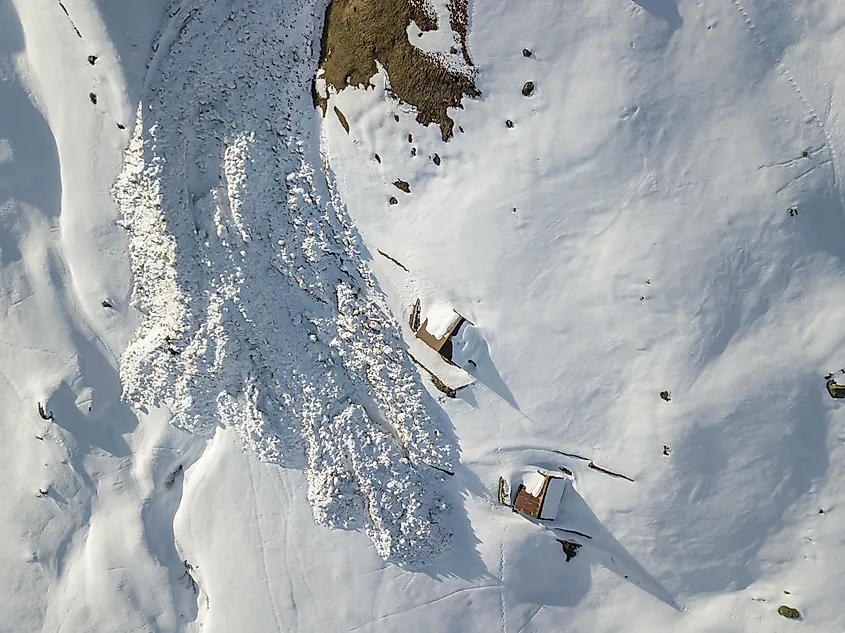
A trigger refers to the source of stress that leads to the overloading of the weak layer, causing it to collapse and the unstable snowpack to avalanche. Triggers can be generated by either natural or human activities. Some natural triggers include rising temperatures that cause the snow to thaw, rainfall on existing snow cover, heavy snowfall, layering of snow, wind-deposited snow, and earthquakes. Anthropogenic activities which act as triggers include movements or vibrations caused by machines and explosives, deforestation, and winter-sport recreations like skiing, snowboarding, and snowmobiling.
Since both landslides and avalanches result in the loss of numerous precious lives, there is an urgent need for intensive mitigation measures. Proper monitoring, forecasting, and effective and timely warnings can save many lives from these disasters. Moreover, protecting forests and planting more trees can help to reduce landslides by helping to hold the soil more tightly. Simple measures like constructing artificial barriers and using boot-packing, ski-cutting, and machine grooming techniques can help prevent avalanches. Furthermore, mitigation plans for other disasters related to landslides and avalanches must also be included in the master plan for risk reduction programs.











